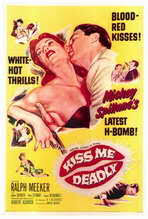
One night, while driving back to Los Angeles, Private Eye Mike Hammer (Ralph Meeker) nearly runs over a woman (Cloris Leachman) trying to flag him down. Swerving to a stop he reluctantly lets her get into his car. She is only wearing a trench coat and is in a panic. At a roadblock he hears that she has escaped from a psychiatric hospital. Something about her terror makes him cover for her. She says her name is Christina and asks him to drop her off at the first bus stop they come to.
Further down the road they are run off the road by another car. Mike is knocked unconscious. He briefly wakens to hear Christina being tortured to death. All he can see are someone’s shoes. He passes out again. Mike is put into his car with Christina’s body and pushed off a cliff. Somehow he manages to survive and wakes up in the hospital. When he wakens his assistant Velda Wickman (Maxine Cooper) is by his side. Police Lt. Pat Murphy (Wesley Addy) walks into the room. Before he can ask any questions Mike is once again out.
When Mike is released from the hospital he is taken to the Interstate Crime Commission to answer some questions but Mike isn’t talking. He really doesn’t know much anyway. All he remembers is that Christina asked him to remember her if she died. The cryptic request weighs heavily on Mike. He decides to investigate her death on his own. That and there’s the thought that whatever her secret was, it was worth a lot of money.
Tossing aside his usually stock and trade of cheating spouse tailing Mike devotes his full attention, and that of his friends, to finding out Christina’s secret. Mike ends up being tailed by Charlie Max (Jack Elam) and Sugar Smallhouse (Jack Lambert), two hoods working for Carlo Evello (Paul Stewart). Carlo, however, is not mister big. To find him Mike travels a long road littered with pitfalls and dangers he’s never seen before. Risking not only his life but the lives of Velma and his buddy Nick (Nick Dennis) to find what he thinks is going to put him on easy street. This time, however, there’s even more at stake. The legendary Pandora’s Box is no longer a legend.
“Kiss Me Deadly” was released in 1955 and was directed by Robert Aldrich. The film is loosely based on the 1952 book by Mickey Spillane. It is a crime drama and a film noir. It also has a science fiction undertone that is not normally seen in the detective fiction genre. The science fiction part is the thing that everybody is after. The box. What’s not spelled out is that the people looking for this prize are not just the government. There is also a vicious group of criminals that want to sell it to a foreign faction. They know what’s in the box. Everybody knows what’s in the box except Mike. It is not a MacGiffin, it is death. The prize that everyone is after is the main thing that differs from Spillane’s book. What was once pulp fiction is now propaganda.
There is a lot of violence in this film. Only nine minutes into the film the torture scene with Christina is short but oh so memorable. At less than a minute long all you see are her legs hanging and jerking and all you hear are her screams, but that’s enough. You don’t really want to know what the pliers were used for. All you know is, that is what finally stopped the screams. It was the last tool used in the toolbox because it was the one that killed her. She is only the first to die violently in this film.
This is not your normal Mike Hammer. He’s narcissistic, vicious and cruel. Hammer is not only hard-boiled, he’s also deep fried. The film circumvents the boundaries of the Production Code and then some.
In the fifties Congress was alarmed by juvenile delinquency in America. A committee was created to investigate the situation. Eventually known as the Kefauver Crime Commission, the committee, led by Senator Estes Kefauver, delved into the question of whether or not comic books corrupted kids. In a sense, comic books were put on trial. Its gaze also turned to movies. One of the outcomes of the committee was the conclusion that, specifically, “Kiss Me Deadly” was a menace to the youth of America. Kefauver issued a special condemnation of the movie and called it immoral entertainment responsible for juvenile delinquency.
For director Aldrich this was the last straw. At one point the film’s ending had been censored. Aldrich initiated a letter writing campaign for free speech rights for independent movie producers. Since “Kiss Me Deadly” was an independent film it could get around the Hayes Code.
In 1999, Kiss Me Deadly was selected for preservation in the United States National Film Registry by the Library of Congress as being "culturally, historically, or aesthetically significant".

